Guaranteed Bat Removal
Fast, safe, reliable wildlife removal
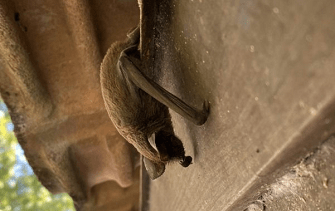
Bat Removal Strategies
Are bats in the attic? Have you seen bat guano? Do you hear scratching, chirping, or flapping above your ceiling?
Whether a maternity colony is roosting in your attic during the summer or bats have flown in to escape cold weather, trust the local experts at Trutech.
Call Trutech In to Get Bats Out.
Bat Problems

Signs a Bat is on Your Property
- Guano. Otherwise known as bat droppings, guano will collect on your deck, windowsills, or attic floor.
- Stains. Bat fur is greasy, and any small areas they’re using to enter your home will become stained, appearing black and shiny.
- Strange odors. Like many wildlife pests, bats stink, and the larger the infestation, the worse the smell. You’ll smell an ammonia-like odor from their urine.
- Bat noises: You’ll hear bats chirping and squeaking and scratching or rustling sounds at night or in the early morning
Identify Bat Noises in Attic

Dangers of Bat Infestation
Bats are not dangerous to people directly, but they can spread diseases and damage your property.
- Bat Guano: Bat guano (droppings) are fertile ground for fungal spores to grow that cause histoplasmosis, a respiratory disease.
- Bat Guano Accumulation: The accumulation of bat guano can degrade the attic insulation, weaken your house structure, and stain your walls and ceiling.
- Rabies: Bats are known carriers of rabies so do not handle them. If a bat is in your living space undetected, get a rabies test. Bat bites can be undetectable.
Humane Bat Removal & Control Strategies

Bat Inspection
Bats will enter homes or yards in search of food and safe shelter. Occasionally, they will rest in the eaves of homes between meals with no intention of staying long-term. Other times, bats accidentally fly into buildings, which can induce panic and incite fear in both residents and pets.

Humane Bat Removal
Large colonies of bats roosting on private properties can become problematic over time. In order to effectively and safely remove them, contact the trained pest professionals at Trutech for safe and humane bat control services. As wild animals, bats claw and bite when unqualified individuals try control without assistance. Wildlife specialists have the knowledge, tools, and training to humanely and efficiently get rid of bats from homes.

Bat Exclusion
Bats enter homes through openings and gaps found near windows, doors, roof lines, and chimneys. In order to prevent entry, seal all holes big enough for bats to fly through with screens, caulk, or grates. Additionally, certain mechanical repellents can be useful, though their legality may vary depending on both state and federal regulations.
Why Are Bats in the Attic?
Bats in the house traditionally roost inside attics or other spaces that provide shelter from the elements and easy access to food sources located nearby. Additionally, bats enter homes in order to birth and foster their young. Some of the more common ways the flying mammals enter homes are through gaps in windows and doors, torn screens, holes in the roof, chimneys, and house vents. Once inside, bats in homes can cause a plethora of problems ranging from illness to property damage.
During spring and summer, female bats search out dark, secluded places to use as nursery roosts. Most species in the United States, such as the little brown bat, big brown bat, Mexican free-tailed bat, and evening bat, prefer to roost in communal groups. Unoccupied attics provide the perfect spots for bats to roost, with warm, dark environments sheltered from predators. The mammals also settle under the eaves of buildings sometimes.

SIGNS OF BATS IN THE HOME
• Ease of Entry: Unlike nuisance animals such as squirrels or raccoons that can tear a hole in a roof, bats are attracted to existing small openings in vents and gaps in soffits, siding, or roof shingles.
• Proximity to Food: For pregnant females, being close to easy meals is key. If your property provides access to a body of water or has fruit trees, bats will congregate. Fields and ponds provide easy access to swarms of insects. Fruit and citrus farmers often attract bats.
• Darkness: A dark attic will allow bats to rest well during the daytime.
• Safety From Outside Elements: Pregnant females and — once they are born — their pups will require warmth and safety. A cozy, dry attic that has enough room for the whole maternity colony and provides safety from predators is preferred.
• Minimal Activity: Bats will not roost where there is frequent human activity.
Why Chose Trutech Wildlife Service
- Guaranteed services
- Over 40 years of experience
- Licenses & insured experts
- Financing available
At Trutech Wildlife Service, we pride ourselves on offering humane raccoon removal services that prioritize the safety of you and your family, your property, and the animal.
Our team of experienced and certified technicians uses humane and eco-friendly methods to ensure a safe and effective removal process. We provide a comprehensive service that includes thorough inspection, humane removal, meticulous damage repair, and proactive prevention measures.
When you choose Trutech Wildlife Service, you can trust that we will handle your raccoon problem with the utmost professionalism and care, giving you peace of mind and a raccoon-free home. Contact us today for a free quote and let us help you reclaim your space.
Bat Removal Near Me

Bats in Jacksonville, FL
There are 13 species of bats in Florida; several of these, including little brown and big brown bats, may be found in residential homes and
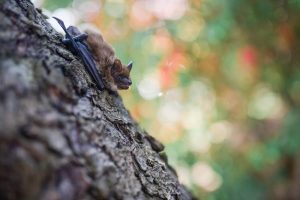
Bats in Tampa-St Petersburg, FL
Florida is home to thirteen bats, and all of them eat insects. Residents in Tampa Bay can experience incredible benefits from bats on their property.
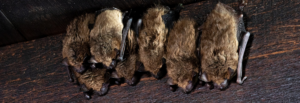
Bats in Orlando, FL
Bats are found in nearly every geographic region in Florida. Their favorite environments include tropical forests, woodlands and open fields. Natural roosting spots include caves,

Bats in Kansas City
Kansas is home to fifteen species of bats, and all of them are insectivores. Bats in Attic in Kansas City Bats in Kansas naturally roost
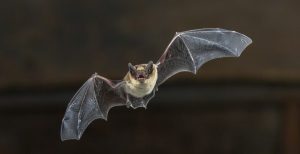
Bat Removal in Northeast Ohio
There are eleven species of bats commonly found in Ohio. The solitary species are the hoary bat, the silver-haired bat, and the Eastern red bat.
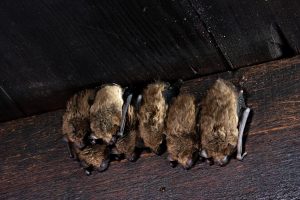
Bat Removal in Raleigh
The most humane way to get rid of bats is to let them evict themselves. A bat valve allows bats to fly out of your
Frequently Asked Questions
Pets are the most likely member of the household to be bitten by a rabid bat, as they are exposed to the risk of infection outdoors and can’t communicate being bitten or feeling ill. However, as one of the primary carriers of rabies in the U.S., bats should be a concern for people as well. When homes are infested, the chances of bat bites on humans are far higher. Sleeping residents can suffer bat bites as can those trying to shoo a trapped bat out of the house. A difficult disease to identify, rabies doesn’t present symptoms for several months. By the time signs like severe fatigue, muscle weakness, and nausea emerge, the deadly disease has often progressed too far to be cured.
Bats are beneficial due to their insect-eating habits, but a quick encounter with them can bring lethal consequences. Immunizations that help prevent rabies are recommended for anyone in an area with high insect activity. Due to the painless nature of bat bites, those who have been near these pests are advised to receive cautionary treatment from a physician. Keep in mind that symptoms typically associated with rabies, such as mouth foaming, aggressiveness, and hydrophobia, are rarely present in humans, so any bite should be treated as a potential threat. When bats are observed in the home, attic, or garage, leave the removal risks to the experts at Trutech.
Unless there is a large number of bats in the attic, infestations can continue for a long time without being noticed by homeowners. Look for the winged animals leaving the attic at dusk and returning sometime during the pre-dawn hours. They can also be detected by noticing stains on exterior walls caused by bat excrement. Inside the house, the smell of guano can become noticeable over time. Large infestations of bats in the attic can deposit enough guano to make the ceiling sag and eventually collapse.
Notoriously nocturnal, bats are also shy creatures that can become expert hiders once in the home. However, bats in the home are largely just accidental occurrences. A single bat can fly into a home without realizing it (despite many incursions pointing to maternal roosting). Homeowners should utilize a variety of methods to verify bat infestations. For one, bats emit high-pitched squeaks and scratching sounds commonly heard in the evening. Bat droppings also tend to accumulate under where the animals roost. Similar in appearance to rodent droppings, bat feces has a pungent odor and appears shiny due to the animals’ diet of insects.
Bats leave plenty of evidence for property owners. For one, seeing the animal flying around treetops and into trees directly tends to be the most common sign. Such behavior occurs in the evening, which makes sighting bats difficult. In such cases, finding bat droppings at the base of a tree is a sure way to know that at least one of the animals is roosting on your property. Noticing missing or damaged bark can also be a sign that bats in trees are present.
Positively identifying what kind of animal is living within the walls is important to begin removal. Bats make high-pitched squeaks, which are employed to find insects and heard mostly during the night. Various scratching and other movements may be heard from walls, as well. If droppings are present, residents should look for dark, greasy scat with visible insect body parts. As finding bat guano within walls can prove difficult, it is wise to check other popular bat hangouts like house eaves and attics.
The only way to permanently keep bats away is with a full exclusion done to the home. This will consist of screening gable end vents, sealing behind fascia board along eaves, sealing construction gaps, sealing dormer corners, sealing ridge caps, and any other areas that will allow a bat to enter into the home. If bats are currently present, a bat valve will be installed which is a one-way door that allows the bats to easily leave the home but does not allow them to get back in. Once all bats have left through the bat valve, it may then be removed and permanently sealed. As for sound machines and repellents, no. Although it may seem that it rustles the bats at first, it is simply the activity of your presence. The bats will soon settle down and continue to roost in that area. If there is a food source present in an area, bats will stay put.
This is something we deal with on a regular basis. If you have this significant of guano buildup, we suggest letting us inspect your property for any other potential entry points. When the bats are evicted from the vent, they will naturally look for another way into their — or in this case, your — home. Also. while you may not see bats in the attic or home, you are not necessarily in the clear. The urine and guano of bats are very corrosive and can deteriorate the bottom of gable vents. Eventually the vent will rot and bats will inhabit the space between the walls and brick, siding, or rock. Don’t procrastinate, as guano can build up fast inside these voids. This not only causes the health risks you hear about but can attract other bats for years to come.

